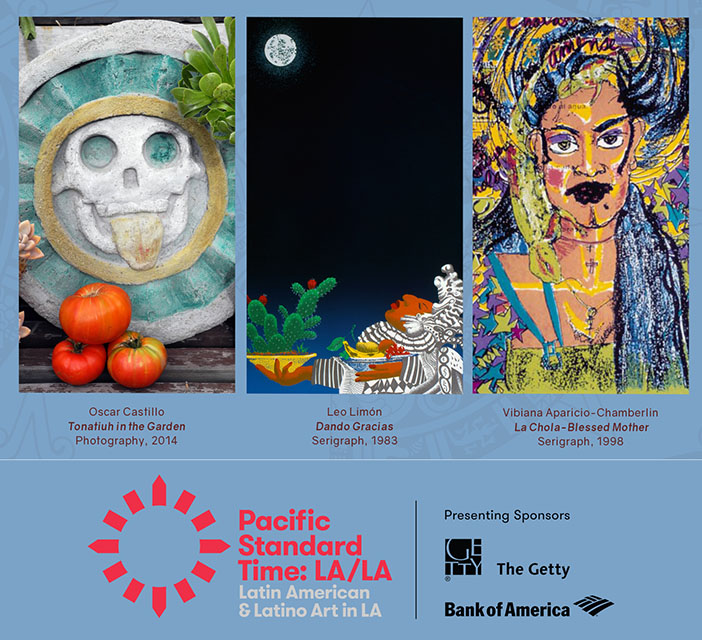 Sept. 6, 2017 — The Chicana/Chicano movement of the 1960s and ‘70s, Mexican iconography and ancient Aztec cosmic female deities are all part of a CSU Channel Islands (CSUCI) art show designed to kick off the University’s participation in the Getty’s institutive Pacific Standard Time: LA/LA.
Sept. 6, 2017 — The Chicana/Chicano movement of the 1960s and ‘70s, Mexican iconography and ancient Aztec cosmic female deities are all part of a CSU Channel Islands (CSUCI) art show designed to kick off the University’s participation in the Getty’s institutive Pacific Standard Time: LA/LA.
Led by the Getty, Pacific Standard Time: LA/LA (PST: LA/LA) is a far-reaching and ambitious exploration of Latin American and Latino art in dialogue with Los Angeles, which takes place from Sept. 2017 through Jan. 2018 at more than 70 cultural institutions across Southern California. The presenting sponsor is Bank of America.
CSUCI’s exhibition “The Latino Museum of History, Art and Culture (1995-2000) Revisited,” is part of the thematically-linked collaboration of exhibits and presentations that reaches from San Diego to Santa Barbara, from Los Angeles to Palm Springs.
Major support for CSUCI’s exhibition was provided by the Garland and Brenda Reiter Foundation and Reiter Affiliated Companies, a fresh berry producer headquartered in Ventura County. The Executive Chairman of Reiter Affiliated Companies, Garland Reiter, said the company was very excited to partner with CSUCI as they launch the exhibit.
“We hope to bring awareness to the many contributions that Latinos make every day to our lives,” Reiter said. “Their history, art and culture is rich and the value they have added to my family’s farming company for generations is real, meaningful and very much alive today.”
The opening of CSUCI exhibits in Napa Gallery and the John Spoor Broome Library Gallery will coincide with the grand opening of PST: LA/LA on Sept. 15, when many of the 70+ participating exhibits open to the public and the four-month celebration of the arts begins.
The public is invited to a PST: LA/LA grand opening reception scheduled for 5 to 8 p.m. on Thursday, Sept. 14 at the John Spoor Broome Library archives courtyard on the CSUCI campus. PST LA/LA runs throughout Southern California through Jan. 31 with a series of visual arts displays, workshops, music, literature, and even cuisine.
CSUCI’s Napa Hall Gallery exhibit will feature Los Angeles artists Vibiana Aparicio-Chamberlin, Oscar Castillo and Leo Limon, who were part of the Latino Museum of History, Art & Culture’s exhibition programming in downtown Los Angeles.
The Broome Library Gallery will feature the work of Cuban-born Paul Sierra, whose work integrates North American influences with Sierra’s Latin visual and cultural roots. It will also present an opportunity to view the Latino Museum’s exhibition history that is part of CSUCI’s unique collection archives.
CSUCI Art History Lecturer Denise Lugo, the founding director of the Latino Museum, is curating the exhibits and coordinating with PST: LA/LA organizers at the Getty. Lugo said she chose the artists for this auspicious exhibition because she wanted to offer a textured view of the “Latinismo” cultural experience in America; the foundation of the museum’s mission statement.
“They really are the epitome of the classical Chicana/o artist who will be remembered for their aesthetic and activism,” Lugo said. “And for securing their place in American art history.”
Oscar Castillo is known for his photographic documentation of the Chicana/o civil rights movement of the 1960s and ‘70s. He kept his lens trained on the Vietnam War protests and other social movements in the streets of East Los Angeles, as well as everyday life in the barrio. Castillo’s love of photography was inspired by the living contrast that was Japan when he was stationed there as a U.S. Marine. Colorful kimonos against the bleak devastation of Hiroshima.
Born in Los Angeles to immigrant parents who fled Mexico during the 1910-1920 Revolution, Leo Limon was also influenced by the social and political activism happening around him. A search for his own Mesoamerican roots led him to an art aesthetic that integrates ancient indigenous culture with modern contemporary life in Los Angeles.
“I hope the public sees my artworks as dynamic vistas into my Chicaná/o spirit and offers perspectives of enlightenment,” he said.
Vibiana Aparicio-Chamberlin is both an artist and a poet, having grown up under the influence of her mother, a Mexican Yaqui storyteller, and her father, a spiritual and intellectual Mexican Indian.
“Art is the language I use to speak my truth in a concrete visual way,” she said. “The five Cs guide me in my work: color, culture, calligraphy, vida cotdiana (the things of everyday life) and creatividad (creativity). I paint and use mixed media to show the beauty and struggle of the Mexican people.”
Aparicio-Chamberlin’s subjects are primarily women, family and Mexican iconography with her poetry often integrated into her visual art.
Some of the other PST: LA/LA events hosted by CSUCI during the four-month celebration will include workshops from all three artists; book-signings, a Day of Dead performance, and art installations along with a film premier screening of the Con Safos documentary along with two panel discussions on the magazine that served as the voice of the Chicana/o artist and activist during the 1960s in East Los Angeles. Additional information can be found by visiting: http://art.csuci.edu/exhibitions/.
Limited parking is available on campus with the purchase of a $6 daily permit; follow signs to the parking permit dispensers. Free parking is available at the Camarillo Metrolink Station/Lewis Road with bus service to and from the campus. Riders should board the CSUCI Vista Bus to the campus; the cash-only fare is $1.25 each way. Buses arrive and depart from the Camarillo Metrolink Station every 30 minutes from 7 a.m. to 10 p.m. Monday through Friday. For exact times, check the schedule at www.goventura.org.
